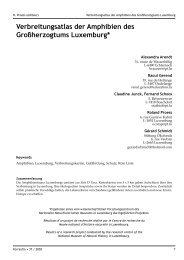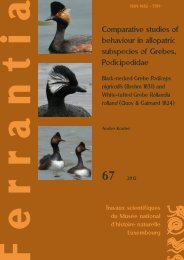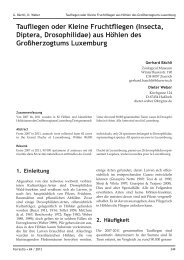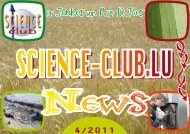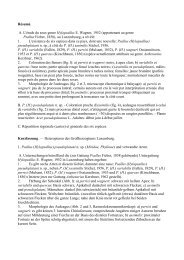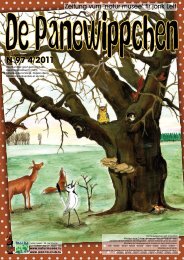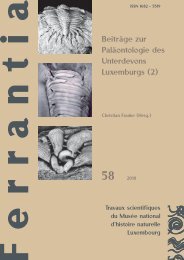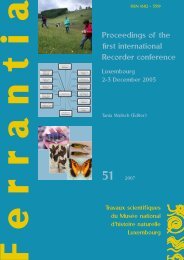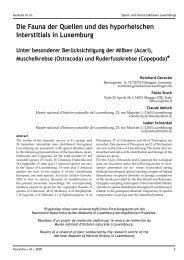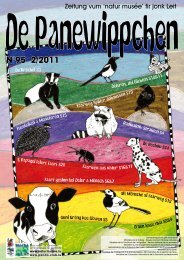Amphipods from caves of the Grand Duchy of Luxembourg
Amphipods from caves of the Grand Duchy of Luxembourg
Amphipods from caves of the Grand Duchy of Luxembourg
You also want an ePaper? Increase the reach of your titles
YUMPU automatically turns print PDFs into web optimized ePapers that Google loves.
J.-F. Flot, D. Weber <strong>Amphipods</strong> <strong>from</strong> <strong>caves</strong> <strong>of</strong> <strong>the</strong> <strong>Grand</strong> <strong>Duchy</strong> <strong>of</strong> <strong>Luxembourg</strong><br />
186<br />
<strong>Amphipods</strong> <strong>from</strong> <strong>caves</strong> <strong>of</strong> <strong>the</strong> <strong>Grand</strong> <strong>Duchy</strong> <strong>of</strong><br />
<strong>Luxembourg</strong><br />
Zusammenfassung<br />
Von 2007 bis 2011 wurden in 82 Höhlen und künstlichen<br />
Hohlräumen des Großherzogtums Luxemburg<br />
Tiere gesammelt. Unter rund 90.000 gesammelten<br />
Tieren waren 130 Flohkrebse. 3 Arten konnten bestimmt<br />
Abstract<br />
From 2007 to 2011, animals were collected in 82 <strong>caves</strong> and<br />
artificial cavities in <strong>the</strong> <strong>Grand</strong> <strong>Duchy</strong> <strong>of</strong> <strong>Luxembourg</strong>. Of<br />
<strong>the</strong> 90,000 individuals sampled, 130 were amphipods<br />
<strong>from</strong> three identified species: Niphargus schellenbergi<br />
Résumé<br />
De 2007 à 2011, des animaux ont été récoltés dans 82<br />
grottes et cavités artificielles du <strong>Grand</strong>-Duché de <strong>Luxembourg</strong>.<br />
Parmi les 90 000 individus récoltés, 130 étaient<br />
des amphipodes appartenant à trois espèces identifiées:<br />
1 Introduction<br />
The amphipod fauna <strong>of</strong> Luxemburg is ra<strong>the</strong>r poor,<br />
with only 14 recorded species (Heuertz 1935;<br />
H<strong>of</strong>fmann 1962; Neitzke 1978; Neitzke & Reichling<br />
1979; Massard & Geimer 1992; Dhur 1993; Dhur<br />
& Massard 1995; Gerecke & al. 2005; Groh &<br />
Allspach 2007): Corophium curvispinum Sars,<br />
1895, Crangonyx pseudogracilis Bousfield, 1958,<br />
Crangonyx subterraneus Bate, 1859, Echinogammarus<br />
berilloni Catta, 1878, Gammarus fossarum Koch,<br />
1836, Gammarus pulex Linnaeus, 1758, Gammarus<br />
roeselii Gervais, 1835, Gammarus tigrinus Sexton,<br />
1939, Microniphargus leruthi Schellenberg, 1934,<br />
Jean-François Flot<br />
Département de Biologie<br />
Facultés Universitaires Notre-Dame de la Paix<br />
Rue de Bruxelles 61<br />
BE-5000 Namur<br />
jean-francois.flot@fundp.ac.be<br />
Dieter Weber<br />
Kirchgasse 124<br />
D-67454 Haßloch<br />
dieter.weber124@gmx.de<br />
werden: Niphargus schellenbergi Karaman, 1932 war die<br />
häufigste Art, gefolgt von Gammarus fossarum Koch, 1836<br />
und Gammarus pulex Linnaeus, 1758.<br />
Karaman, 1932 was <strong>the</strong> most common species, followed<br />
by Gammarus fossarum Koch, 1836 and Gammarus pulex<br />
Linnaeus, 1758.<br />
Niphargus schellenbergi Karaman, 1932 était l'espèce la<br />
plus fréquente, suivie par Gammarus fossarum Koch, 1836<br />
et Gammarus pulex Linnaeus, 1758.<br />
Niphargus aquilex Schiödte, 1855, Niphargus<br />
fontanus Bate, 1858, Niphargus schellenbergi<br />
Karaman, 1932, Niphargus virei Chevreux, 1896,<br />
and Orchestia cavimana Heller, 1865. Among <strong>the</strong>se<br />
14 species, six (C. curvispinum, C. pseudogracilis, E.<br />
berilloni, G. roeselii, G. tigrinus, and O. cavimana)<br />
are recent additions to <strong>the</strong> local fauna (H<strong>of</strong>fmann<br />
1962; Dhur & Massard 1995; Massard & Geimer<br />
1992; Dhur 1993; Gerecke & al. 2005), whereas all<br />
eight autochthonous species (G. fossarum, G. pulex,<br />
C. subterraneus, M. leruthi, N. aquilex, N. fontanus,<br />
N. schellenbergi, and N. virei) have been reported<br />
to occur occasionally or regularly in <strong>caves</strong> and<br />
artificial cavities in <strong>Luxembourg</strong> (H<strong>of</strong>fmann 1962;<br />
Gerecke & al. 2005; Weber 2011, 2011a).<br />
Ferrantia • 69 / 2013
J.-F. Flot, D. Weber <strong>Amphipods</strong> <strong>from</strong> <strong>caves</strong> <strong>of</strong> <strong>the</strong> <strong>Grand</strong> <strong>Duchy</strong> <strong>of</strong> <strong>Luxembourg</strong><br />
2 Frequency <strong>of</strong> amphipods in<br />
<strong>Luxembourg</strong> <strong>caves</strong><br />
The proportion <strong>of</strong> amphipods in <strong>the</strong> samples<br />
analyzed is modest (130 collected specimens out<br />
<strong>of</strong> ca. 90,000). Among <strong>the</strong> 82 <strong>caves</strong> studied, only<br />
14 contain sufficient water for sieve collections<br />
but each <strong>of</strong> <strong>the</strong>se 14 <strong>caves</strong> yielded amphipods:<br />
amphipods are <strong>the</strong>refore commonly observed in<br />
cave waters in <strong>Luxembourg</strong>.<br />
3 Cave amphipod species <strong>of</strong><br />
<strong>Luxembourg</strong><br />
Out <strong>of</strong> <strong>the</strong> 8 species previously reported <strong>from</strong><br />
<strong>caves</strong>, only 3 were observed among <strong>the</strong> individuals<br />
collected in <strong>the</strong> present study: Gammarus fossarum<br />
(6 identified specimens), G. pulex (two identified<br />
specimens), Niphargus schellenbergi (26 identified<br />
specimens).<br />
3.1 Crangonyctidae Bousfield, 1973<br />
No crangonyctid was collected in <strong>the</strong> present<br />
study.<br />
Crangonyx subterraneus Bate, 1859<br />
This species was rarely collected in <strong>Luxembourg</strong>:<br />
H<strong>of</strong>fman (1962) mentions five collection sites,<br />
mostly wells and spring but also in a mine near<br />
Heisdorf.<br />
3.2 Gammaridae Latreille, 1802<br />
Out <strong>of</strong> <strong>the</strong> 33 gammarids collected in <strong>the</strong> present<br />
study, only eight could be identified down to<br />
species level (identifications were solely based<br />
on morphology as <strong>the</strong>se specimens were not<br />
preserved in a way suitable for DNA taxonomy).<br />
Gammarus fossarum Koch, 1836<br />
This species is widely distributed in Europe. It is<br />
predominantly found in surface waters and occurs<br />
in <strong>caves</strong> as well (H<strong>of</strong>fmann 1962). Six collected<br />
specimens <strong>from</strong> Tunnel Huldange in <strong>the</strong> North<br />
<strong>of</strong> <strong>Luxembourg</strong> were attributed to this species.<br />
25 additional specimens <strong>from</strong> <strong>the</strong> same location<br />
were too small to be determined correctly but may<br />
belong to <strong>the</strong> same species.<br />
G. fossarum is considered in <strong>the</strong> older literature<br />
as eutrogloxene (Leruth 1939; Strinati 1965;<br />
Dobat 1975; Weber 1991), but more recently as<br />
eutroglophile (Zaenker 2001; Weber 2012).<br />
Gammarus pulex Linnaeus, 1758<br />
This species is common in springs, streams and<br />
ponds in Europe and is also sometimes found at<br />
<strong>the</strong> entrance <strong>of</strong> underground passages (H<strong>of</strong>fmann<br />
1962). Two collected specimens <strong>from</strong> Tunnel<br />
Huldange in <strong>the</strong> North <strong>of</strong> <strong>Luxembourg</strong> were<br />
attributed to this species.<br />
G. pulex is considered as eutrogloxene (Dobat<br />
1978; Weber 1991, 2012).<br />
3.3 Niphargidae Bousfield, 1977<br />
Niphargids were found in all 14 <strong>caves</strong> that<br />
contained water. 97 specimens were observed<br />
and identified morphologically as belonging to<br />
<strong>the</strong> genus Niphargus. 26 specimens <strong>from</strong> 8 <strong>caves</strong><br />
were identified down to species-level using DNA<br />
sequencing: briefly, samples preserved in 70%-96%<br />
ethanol were dissected and DNA extracted <strong>from</strong><br />
one or two legs, <strong>the</strong>n subjected to polymerase<br />
chain reaction (PCR) in order to amplify and<br />
sequence a set <strong>of</strong> taxonomically informative<br />
markers (COI, 12S, 28S; see Flot 2010 and Flot & al.<br />
2010 for detailed descriptions <strong>of</strong> <strong>the</strong> methods). All<br />
sequenced specimens were identified as N. schellenbergi.<br />
Specimens <strong>from</strong> <strong>the</strong> 6 o<strong>the</strong>r <strong>caves</strong> ei<strong>the</strong>r<br />
escaped during collection or were not preserved<br />
in a way suitable for DNA sequencing, but as<br />
<strong>the</strong>se <strong>caves</strong> were located very close to <strong>caves</strong> where<br />
N. schellenbergi was present it is probable that all<br />
<strong>the</strong> individuals observed in <strong>the</strong> present study<br />
belonged to <strong>the</strong> same species.<br />
Microniphargus leruthi Schellenberg, 1934<br />
This very small species was only reported <strong>from</strong><br />
one site in Luxemburg, <strong>the</strong> underground galleries<br />
<strong>of</strong> Oberwampach draining <strong>the</strong> water <strong>of</strong> <strong>the</strong><br />
abandoned galena mine <strong>of</strong> Allerborn (H<strong>of</strong>fmann<br />
1962). It was not collected in <strong>the</strong> present study.<br />
Niphargus aquilex Schiödte, 1855<br />
This species is common in Nor<strong>the</strong>rn Europe,<br />
including Great-Britain (Hartke & al. 2011).<br />
Ferrantia • 69 / 2013 187
J.-F. Flot, D. Weber <strong>Amphipods</strong> <strong>from</strong> <strong>caves</strong> <strong>of</strong> <strong>the</strong> <strong>Grand</strong> <strong>Duchy</strong> <strong>of</strong> <strong>Luxembourg</strong><br />
188<br />
Stoch in Gerecke & al. (2005) collected it only<br />
<strong>from</strong> <strong>the</strong> hyporheos but not <strong>from</strong> springs: <strong>the</strong><br />
strong preference <strong>of</strong> this species for interstitial<br />
environments probably explains why it was not<br />
observed in <strong>the</strong> present study (Stoch, pers. comm.).<br />
Niphargus fontanus Bate, 1858<br />
This species is considered common in Nor<strong>the</strong>rn<br />
Europe, including Great-Britain (Hartke & al.<br />
2011). H<strong>of</strong>fman (1962) reports it <strong>from</strong> several<br />
mines (notably <strong>the</strong> Langebierg iron ore mine near<br />
Dudelange), but it was not observed in Gerecke<br />
& al. (2005) nor in <strong>the</strong> present study. N. fontanus<br />
is difficult to distinguish morphologically <strong>from</strong><br />
N. schellenbergi without dissecting mouthparts,<br />
resulting in frequent misidentification (Hartke &<br />
al. 2011): <strong>the</strong>refore, additional investigation will<br />
be required to confirm or infirm <strong>the</strong> early reports<br />
<strong>of</strong> this species in <strong>Luxembourg</strong>.<br />
Niphargus schellenbergi Karaman, 1932<br />
This species is very common in Nor<strong>the</strong>rn Europe,<br />
but absent <strong>from</strong> <strong>the</strong> United Kingdom (Hartke &<br />
al. 2011). It was by far <strong>the</strong> most abundant cave<br />
amphipod observed in <strong>Luxembourg</strong> in <strong>the</strong> course<br />
<strong>of</strong> this study, with 26 identified specimens (all<br />
confirmed using DNA sequencing) <strong>from</strong> <strong>the</strong> very<br />
north to <strong>the</strong> very south <strong>of</strong> <strong>the</strong> country.<br />
N. schellenbergi is a typical inhabitant <strong>of</strong><br />
groundwaters, including <strong>caves</strong>, and is considered<br />
an troglobiont / eutroglobiont (Weber 1991, 1997,<br />
2012; Zaenker 2007).<br />
140 #<br />
130 #<br />
120 #<br />
110 #<br />
100 #<br />
90 #<br />
80#<br />
70#<br />
60#<br />
Gammarus fossarum<br />
#<br />
# # # # # #<br />
50 60 70 80 90 100 110<br />
Fig. 1. Caves with Gammarus<br />
fossarum in Luxemburg.<br />
N<br />
0 10Km<br />
#<br />
140 #<br />
130 #<br />
120 #<br />
110 #<br />
100 #<br />
90 #<br />
80#<br />
70#<br />
60#<br />
Gammarus pulex<br />
#<br />
# # # # # #<br />
Fig. 2. Caves with Gammarus<br />
pulex in Luxemburg.<br />
Niphargus virei Chevreux, 1896<br />
This species is abundant in France but quite rare in<br />
Luxemburg: H<strong>of</strong>fman (1962) reports it only <strong>from</strong><br />
one spring and one mine (<strong>the</strong> Langebierg iron ore<br />
mine near Dudelange). It was not observed in <strong>the</strong><br />
present study.<br />
4 Acknowledgments<br />
We thank Fabio Stoch (L'Aquila), Nico Schneider<br />
(<strong>Luxembourg</strong>) and Stefan Zaenker (Fulda)<br />
for checking <strong>the</strong> manuscript; thanks also to<br />
Jos Massard (Echternach) and Guy Dhur<br />
(Bettembourg) for providing some <strong>of</strong> <strong>the</strong> literature<br />
cited.<br />
5 Bibliography<br />
50 60 70 80 90 100 110<br />
Dhur G., 1993. - Etude des espèces d'Invertébrés<br />
immigrées ou introduites dans la Moselle<br />
luxembourgeoise et les écosystèmes aquatiques<br />
qui en dépendent. Historique et répartition<br />
actuelle, Mémoire scientifique non publié, 213<br />
pp., <strong>Luxembourg</strong>.<br />
Dhur G. & Massard J.A. 1995. - Etude historique et<br />
faunistique des Invertébrés immigrés ou introduits<br />
dans la Moselle luxembourgeoise et ses<br />
affluents. Bulletin de la Société des Naturalistes<br />
luxembourgeois 96: 127-156.<br />
N<br />
0 10Km<br />
#<br />
140 #<br />
130 #<br />
120 #<br />
110 #<br />
100 #<br />
90 #<br />
80#<br />
70#<br />
60#<br />
#<br />
#<br />
#<br />
#<br />
#<br />
Niphargus<br />
# ## #<br />
# # # # # #<br />
50 60 70 80 90 100 110<br />
Fig. 3. Caves with Niphargus schellenbergi<br />
in Luxemburg.<br />
Ferrantia • 69 / 2013<br />
N<br />
0 10Km<br />
#
J.-F. Flot, D. Weber <strong>Amphipods</strong> <strong>from</strong> <strong>caves</strong> <strong>of</strong> <strong>the</strong> <strong>Grand</strong> <strong>Duchy</strong> <strong>of</strong> <strong>Luxembourg</strong><br />
Fig. 4: Niphargus schellenbergi <strong>from</strong> <strong>the</strong> K<strong>of</strong>ferminn Stolzebuerg Hauptsystem.<br />
Fig. 5: Niphargus schellenbergi in <strong>the</strong> K<strong>of</strong>ferminn Stolzebuerg Hauptsystem.<br />
Ferrantia • 69 / 2013 189
J.-F. Flot, D. Weber <strong>Amphipods</strong> <strong>from</strong> <strong>caves</strong> <strong>of</strong> <strong>the</strong> <strong>Grand</strong> <strong>Duchy</strong> <strong>of</strong> <strong>Luxembourg</strong><br />
190<br />
Dobat K. 1975. - Die Höhlenfauna der Schwäbischen<br />
Alb mit Einschluss des Dinkelberges,<br />
des Schwarzwaldes und des Wutachgebietes.<br />
Abhandlungen zur Karst- und Höhlenkunde,<br />
Reihe D, Paläontologie, Zoologie, 2: 260 - 381,<br />
München.<br />
Dobat K. 1978. - Die Höhlenfauna der Fränkischen<br />
Alb. Abhandlungen zur Karst- und Höhlenkunde,<br />
Reihe D, Paläontologie, Zoologie, 3:<br />
11-240, München.<br />
Flot J.-F. 2010. - Vers une taxonomie moléculaire<br />
des amphipodes du genre Niphargus : exemples<br />
d'utilisation de séquences d'ADN pour l'identification<br />
des espèces. Bulletin de la Société<br />
des Sciences Naturelles de l'Ouest de la France<br />
32(2): 62-68.<br />
Flot J.-F., Wörheide, G., Dattagupta, S. 2010. -<br />
Unsuspected diversity <strong>of</strong> Niphargus amphipods<br />
in <strong>the</strong> chemoautotrophic cave ecosystem <strong>of</strong><br />
Frasassi, central Italy. BMC Evolutionary<br />
Biology 10: 171<br />
Gerecke R., Stoch, F., Meisch, C., Schrankel, I.<br />
2005. - Die Fauna der Quellen und des hyporheischen<br />
Interstitials in <strong>Luxembourg</strong>. Ferrantia<br />
41: 1-140.<br />
Groh K. & Allspach, A., 2007. - Flohkrebse und<br />
Asseln - gammarides et cloportes - Crustacea,<br />
Amphipoda et Isopoda. In: Meyer, M. &<br />
Carrières, E. (Coord.). Inventaire de la biodiversité<br />
dans la forêt "Schnellert" (Commune de<br />
Berdorf). Ferrantia 50: 223-233.<br />
Hartke T.R., Fišer, C., Hohagen, J., Kleber,<br />
S., Hartmann, R. & Koenemann, S. 2011. -<br />
Morphological and molecular analyses <strong>of</strong><br />
closely related species in <strong>the</strong> stygobiontic genus<br />
Niphargus (Amphipoda). Journal <strong>of</strong> Crustacean<br />
Biology 31(4): 701-709.<br />
Heuertz F. 1935. - Les Gammares. Bulletin de la<br />
Société des Naturalistes luxembourgeois 29:<br />
186-188.<br />
H<strong>of</strong>fmann J. 1962. - Faune des Amphipodes du<br />
<strong>Grand</strong>-Duché de <strong>Luxembourg</strong>. Archives de la<br />
Section des Sciences de l'Institut <strong>Grand</strong>-Ducal,<br />
Nouvelle Série 29: 1-128.<br />
Leruth R. 1939. - La biologie du domaine souter-<br />
rain et la faune cavernicole de la Belgique.<br />
Mémoire du Musée royal d'Histoire naturelle<br />
de Belgique, 87: 1 - 506, Bruxelles.<br />
Massard J.A. & Geimer, G. 1992. - Découverte de<br />
Gammarus tigrinus Sexton, 1939 dans la Moselle<br />
frontalière entre le <strong>Luxembourg</strong> et l'Allemagne<br />
(Crustacea: Amphipoda). Bulletin de la Société<br />
des Naturalistes luxembourgeois 93: 195-198.<br />
Neitzke C. 1978. - Zur Kenntnis des Makrozoobenthons<br />
der Mosel: Weichtiere (Mollusca).<br />
Wissenschaftliche Hausarbeit zum Staatsexamen<br />
für das Lehramt an Gymnasien, Mainz.<br />
Neitzke C. & Reichling, R. 1979. - Veränderungen<br />
des Makrozoobenthons der Mosel zwischen<br />
Schengen und Koblenz. Mainzer Naturwissenschaftliches<br />
Archiv 17: 165-170.<br />
Strinati P. 1965. - Faune cavernicole de la Suisse:<br />
1-484, Éditions du Centre national de la<br />
recherche scientifique, Paris.<br />
Weber D. 1991. - Die Evertebratenfauna der<br />
Höhlen und künstlichen Hohlräume des<br />
Katastergebietes Westfalen einschliesslich<br />
der Quellen- und Grundwasserfauna. Abhandlungen<br />
zur Karst- und Höhlenkunde, 25: 1 -<br />
701, München.<br />
Weber D. 1997. - Einführung in die Biospeläologie<br />
mit Schwerpunkt Deutschland. Mitteilungen<br />
der Höhlenforschergruppe Karlsruhe, 11 (2.<br />
Aufl.): 1-112, Karlsruhe.<br />
Weber D. 2011. - Höhlenfaunenerfassung<br />
in Luxemburg – 51. Jahrestagung<br />
und Karstsymposium im Fledermaus-Zentrum<br />
Bad Segeberg: 53-56, Bad Segeberg.<br />
Weber D. 2011a. - Höhlenfaunenerfassung in<br />
Luxemburg – Mitteilungen des Verbandes der<br />
deutschen Höhlen- und Karstforscher e.V., Jg.<br />
2011(3): 99-100, München .<br />
Weber D. 2012. - Die Höhlenfauna und -flora<br />
des Höhlenkatastergebietes Rheinland-Pfalz/<br />
Saarland, 5. Teil. Abhandlungen zur Karst- und<br />
Höhlenkunde, 36: 2367 S., München.<br />
Zaenker S. 2001. - Das Biospeläologische Kataster<br />
Hessen. Die Fauna der Höhlen, künstlichen<br />
Hohlräume und Quellen. Abhandlungen zur<br />
Karst- und Höhlenkunde, 32: CD-Version,<br />
München.<br />
Zaenker S. 2007. - Das Biospeläologische Kataster<br />
Hessen. Die Fauna der Höhlen, künstlichen<br />
Hohlräume und Quellen. Unpublished (update<br />
<strong>from</strong> Zaenker 2001).<br />
Ferrantia • 69 / 2013



